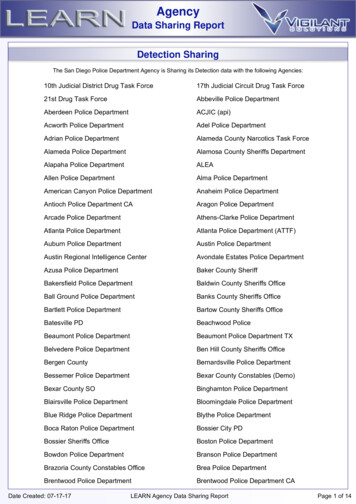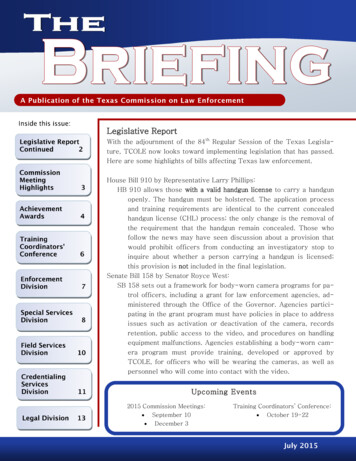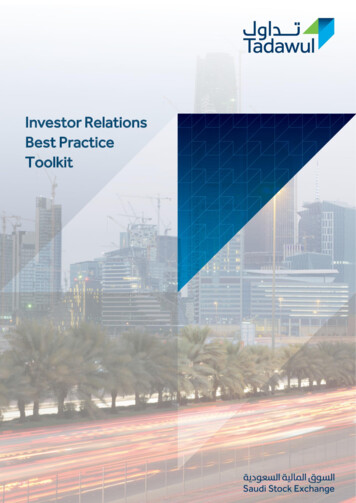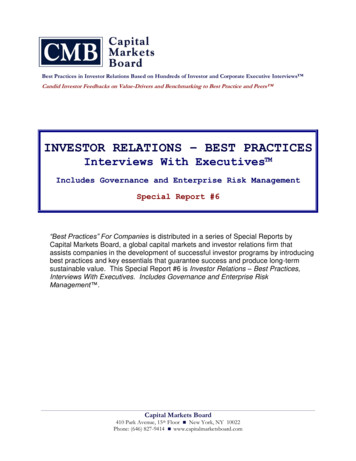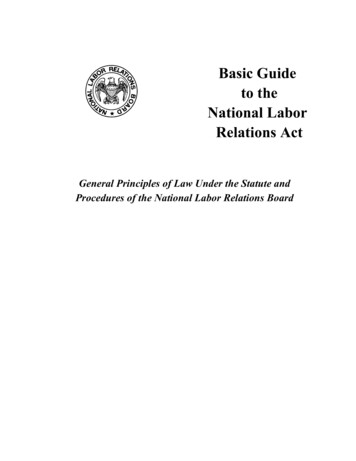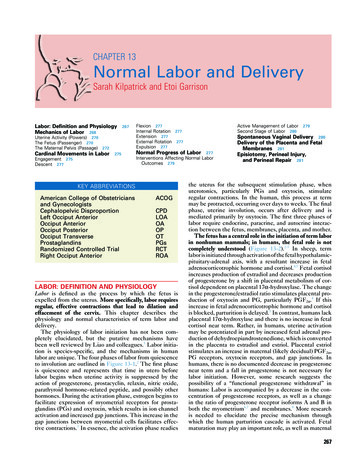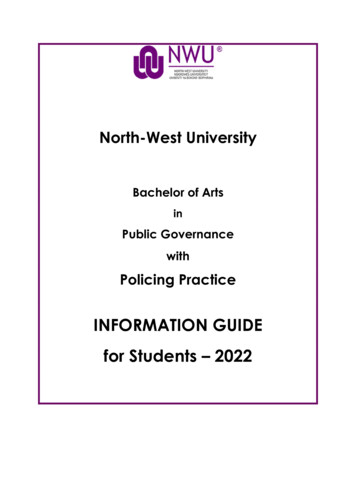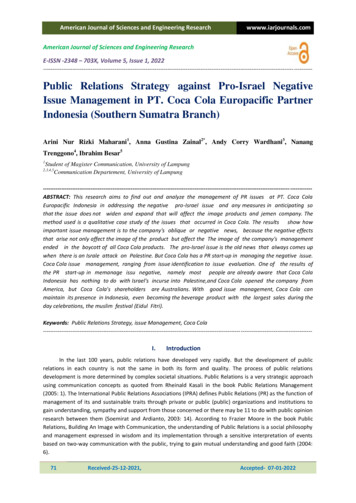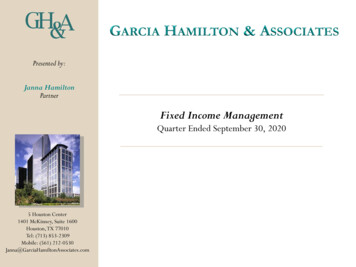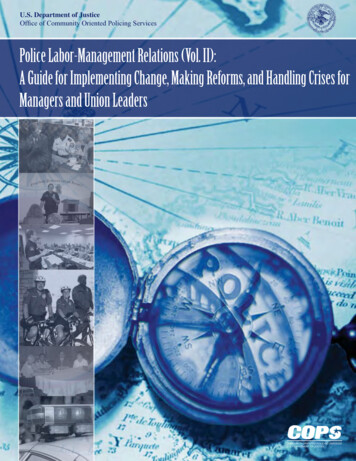
Transcription
U.S. Department of JusticeOffice of Community Oriented Policing ServicesPolice Labor-Management Relations (Vol. II):A Guide for Implementing Change, Making Reforms, and Handling Crises forManagers and Union LeadersCOPSCOMMUNITY ORIENTED POLICING SERVICESU.S. DEPARTMENT OF JUSTICE
Police Labor-Management Relations (Vol. II):A Guide for Implementing Change, Making Reforms, and HandlingCrises for Managers and Union LeadersByMichael J. PolzinAssistant ProfessorSchool of Labor and Industrial RelationsMichigan State UniversityandRonald G. DeLordPresidentCombined Law Enforcement Associations of TexasThis project was supported by cooperative agreement #2001CKWXK093 by the Office of CommunityOriented Policing Services, U.S. Department of Justice. The opinions contained herein are those ofthe author(s) and do not necessarily represent the official position of the U.S. Department of Justice.References to specific companies, products, or services should not be considered an endorsement ofthe product by the author(s) or the U.S. Department of Justice. Rather, the references are illustrations tosupplement discussion of the issues.www.cops.usdoj.gov1-932582-69-XAugust 2006
NAcknowledgementsWEsAcknowledgementsPolice Labor-Management Relations (Vol. II): A Guide for Implementing Change, Making Reforms, andHandling Crises for Managers and Union Leaders was funded by a grant from the Office of CommunityOriented Policing Services (the COPS Office) of the U.S. Department of Justice.The authors of this guide wish to thank the COPS Office for its assistance in completing this publication.Senior Social Science Analyst Robert Chapman and former Senior Social Science Analyst Veh Bezdikanof the Program/Policy Support and Evaluation Division were the catalysts for this project. Their foresight,guidance, and support were invaluable.This guide provides police managers and union leaders with a method and tools to help them to work moreeffectively together in implementing change, make reforms and handle crises within their departments. It isan offshoot of a larger project funded and initiated by the COPS Office to unravel the world of police labormanagement relations and offer practical and principled solutions for putting aside traditional adversarialismand working more effectively together. A related volume, Police Labor-Management Relations (Vol. I):Perspectives and Practical Solutions for Implementing Change, Making Reforms, and Handling Crises forManagers and Union Leaders, edited by Ronald Delord and Jerry Sanders, is also a product of that initiative.The authors of Police Labor-Management Relations (Vol. II): A Guide for Implementing Change, MakingReforms, and Handling Crises for Managers and Union Leaders were Michael J. Polzin, assistant professorand administrator of the Program on Innovative Employment Relations Systems at the School of Labor andIndustrial Relations at Michigan State University, and Ronald G. DeLord, president of the Combined LawEnforcement Associations of Texas.The authors acknowledge and thank Kristine White, Tina Riley, and Mark Roehling of the School of Laborand Industrial Relations, Michigan State University, and Mark Alley, chief of the Lansing, Michigan, PoliceDepartment, for their comments and editorial assistance in completing this guide. The authors are indebtedto John Beck, Julie Brockman, and Donna Winthrop, their colleagues in the Program on InnovativeEmployment Relations Systems, School of Labor and Industrial Relations, Michigan State University, whosework and whose ideas about facilitating joint labor-management cooperative efforts contributed to thethinking from which we have drawn.i
NAbout the AuthorsWEsAbout the AuthorsMichael J. PolzinMike is an assistant professor in the School of Labor and Industrial Relations (SLIR) at Michigan StateUniversity. Much of his teaching and training is with unions and union-management groups. He facilitateschange initiatives that are jointly designed and implemented by union and management. He teaches acourse on Training and Development in SLIR’s master’s degree program and teaches an undergraduatecourse on Research, Communication, and Presentations Skills in SLIR’s Modern Labor Concepts Certificateprogram offered to union members. Mike also directs the school’s Police Union Executive LeadershipProgram. Mike has been engaged in workplace education and organizational development for more than20 years. He spent 3 years with District 1199C, National Union of Hospital and Health Care Employees,as deputy director of a statewide training and upgrading program for nursing home workers. For 5 years,Mike worked on the education/organizational development staff of a Philadelphia-based consulting firm thatcreated democratically structured, unionized, employee-owned enterprises. Mike also worked for severalyears on the staff of the Michigan Governor’s Office for Job Training to promote employee ownership,gainsharing, and participative work systems to union and management leaders throughout the state. Mikehas taught in the Labor Studies Program of Penn State University and the Union Leadership Academyof Rutgers University. He has also taught courses for Grand Valley State University and in the Master ofManagement program of Aquinas College. Mike holds a degree in psychology from Aquinas College and adoctorate in adult education from Temple University. His doctoral dissertation explored intrinsic and extrinsicfactors that influenced worker participation in workplace decision making.Ronald G. DeLordRon was a patrol officer for the Beaumont (Texas) Police Department from 1969 to 1972. He served as apatrol officer and detective for the Mesquite (Texas) Police Department from 1972 to 1977. In 1977 he wasone of the founders of the Combined Law Enforcement Associations of Texas (CLEAT) and was electedits first president. He is currently serving his ninth 3-year elected term. CLEAT is the state’s largest policeunion with more than 13,500 rank-and-file members. Ron is the coauthor of Police Power, Politics andConfrontation: A Guide for the Successful Police Labor Leader (Charles C. Thomas, Publishers); coauthorof “Unionization” in The Encyclopedia of Police Science (Garland Publishing); editor-in-chief of The UltimateSacrifice: The Trials and Triumphs of the Texas Peace Officer (Wadsworth Publishing); and he is a frequentcolumnist for American Police Beat newspaper with a circulation of 100,000. He is a principal partner in thePolice and Fire Labor Institute that has conducted labor training programs for police and fire labor leadersin the United States, Canada, Australia, and New Zealand. He is a frequent lecturer on police labor relationsat seminars, universities, and training programs. Ron graduated from the 10-week Harvard Trade UnionProgram in 1992. He has a bachelor of science degree in government from Lamar University in Beaumont,Texas; a master of arts degree in police science and administration from Sam Houston State University inHuntsville, Texas; and a doctorate of jurisprudence degree from South Texas College of Law in Houston,Texas. He has been a licensed attorney in Texas since 1987.iii
NAuthors’ NoteWEsAuthors’ NoteTo simplify the terms used in this training guide, the term “police,” “police officer,” “police department,” or“law enforcement agency” will include municipal, county, special district, state, or federal law enforcementofficers and agencies. The term “police chief” will include police chiefs, sheriffs, constables, or the head ofa law enforcement agency. The term “police manager or police management” will include the head of thelaw enforcement agency and the command staff of the agency. The term “government administration” willinclude city managers, county managers, or the chief administrative officers of municipal, county, specialdistricts, state, and federal governments.In the public sector, especially among law enforcement labor organizations, one is more likely to see theterms “association or lodge,” instead of “union,” attached to the name of the organization. The FraternalOrder of Police (FOP) uses the word “lodge” to describe its affiliated groups. Some organizations use“association” in their name and are also FOP lodges. Affiliates of the International Union of PoliceAssociations (IUPA, AFL-CIO) and the International Brotherhood of Police Officers (IBPO/NAGE, AFL-CIO)tend to use the term “union” more often in their organizational names. Independent law enforcement labororganizations, not affiliated with FOP, tend to use combinations of the terms “police officers’ association,”“police association,” or “police benevolent association.” Independent labor organizations in sheriff’sdepartments generally use “deputy sheriff’s association,” “sheriff’s officers’ association,” or “deputy sheriff’sbenevolent association.” There is no one common denominator when it comes to organizational names oraffiliations.We will use the term “police union” to include all law enforcement labor organizations regardless of theiragency or organizational affiliation. With 80 percent or more of the nation’s law enforcement officersin employee organizations unaffiliated with the AFL-CIO, the use of the term “union” causes many lawenforcement officers to bristle and try to explain how their employee organization is really an association orlodge. It is just a matter of semantics because associations, unions, and lodges are labor organizations ifthey are formed by dues-paying employees desiring to improve their wages, hours, and working conditionsthrough collective bargaining, collective action, or collective begging.
NIntroductionWEsIntroduction“New mayor promises to clean up police department.”“Community groups demand public accountability of police.”“Shooting death by police officers of unarmed man results in riot.”Unfortunately, every police agency in the United States can expect to see headlines such as these atsome point. Every police manager and police union leader will be faced with the media circus and stressescreated when change, reform, or a crisis hits the agency. Police managers and police union leaders need tounderstand that there are ways they can work together to resolve these issues and maintain a cooperativelabor-management relationship.This guide, and the book to which it is a complement (Police Labor-Management Relations (Vol. I):Perspectives and Practical Solutions for Implementing Change, Making Reforms, and Handling Crises forManagers and Union Leaders), were created because there are no educational and training programs forpolice union leaders and police management that focus on how to implement change in a law enforcementagency in a cooperative manner, how to work together to obtain reforms within the agency, or what to doduring a crisis to avoid escalating the situation. While there are training manuals, seminars, and literatureon traditional police labor-management relations, these programs generally are targeted toward wages,hours, and conditions of employment in law enforcement agencies with formalized collective bargaining or agrievance procedure. Traditional labor-management programs are designed to have a “winner” and “loser” ineach situation. The need for cooperative interactions between police unions and police management occurdaily and not just during the collective bargaining process, grievances, or arbitration.In early 2002, the Office of Community Oriented Policing Services of the United States Department ofJustice funded a project to address this situation. The goals of the project were to do the following:1) Survey police union and police management on the current state of labor-management relations withan emphasis on implementing change in the proper direction, and also on the operations of the lawenforcement agency with an emphasis on reform efforts.2) Analyze the survey data to determine those aspects of the labor-management relationship that wouldappear to be the most cooperative and those aspects that would appear to be the least cooperativewhen the law enforcement agency is desirous of change or reform, i.e., what is working and what isnot.3) Create a model police labor-management process to implement change and reform the lawenforcement agency.4) Establish methods to encourage police unions and police management to work together to make thereduction of crime a part of their relationship (with or without the right to collectively bargain) and todevelop a shared vision of a safer community.5) Develop an educational and training program for police union leaders and police management in howto implement change in a law enforcement agency in a cooperative manner. ii
NWEPolice Labor-Management Relations (Vol. II)sThe first four goals were achieved in Police Labor-Management Relations (Vol. I): Perspectives andPractical Solutions for Implementing Change, Making Reforms, and Handling Crises for Managers andUnion Leaders. It was decided to place the fifth goal of the project into a supplemental training guide to useseparately for in-service training, seminars, conferences, and self-facilitated instruction. It is critical that oneread Volume I before reading this training guide to understand all of the concepts for developing cooperativepolice labor-management relations.This volume, Police Labor-Management Relations (Vol. II): A Guide for Implementing Change, MakingReforms, and Handling Crises for Managers and Union Leaders is divided into four chapters.Chapter One focuses on starting the informal processes for building cooperative police labor-managementrelations. Often, police management or the police union may recognize a need to open the door tocommunications, but the other party does not appear to be interested.Chapter Two focuses on the formal process of building joint police labor-management relations, charteringthe effort, and creating an agenda for change.Chapter Three focuses on teaching management and labor a practical tool to use in problem solving andplanning in any of a number of situations including implementing change, making reforms, and handlingcrises.Chapter Four provides three simulated real-life cases to which union-management groups can apply theproblem-solving method to increase their understanding of how the method works and to build capability sothat they can apply it to their own concerns.The guide illustrates for union and management leaders how a cooperative labor-management effort canbe developed within their departments. Some departments may be able to follow the guide and facilitatethe cooperative efforts themselves. Certainly, Chapter One provides practical information to help anydepartment improve the relations between union and management. The rest of the guide is written for thosedepartments that wish to use the strengthened relationship to strengthen the department and improve theservice provided to constituents. iii
NContentsWEsCONTENTSAcknowledgements . iAbout the Authors . iiiAuthors’ Note . vIntroduction . viiChapter OneInformal Processes for Building CooperativePolice Labor-Management Relations . 1Chapter TwoExploring and Beginning a Joint labor-Management Effort:Creating the Charter and Setting an Agenda . 9Chapter ThreeDeveloping Skills for Effective Joint Labor-Management Change . 33Chapter FourApplying the Interest-Based, Problem-Solving Method . 49ix
NWEsCHAPTER ONE:Informal Processes for Building Cooperati ePolice Labor-Management Relations
NInformal Process for Building Cooperative Police Labor-Management RelationsWEsINFORMAL PROCESSES FOR BUILDING COOPERATIVEPOLICE LABOR-MANAGEMENT RELATIONSIn a perfect world, both police managers and police union leaders want to work together to make theircommunity a safer place to live. The parties would openly communicate, cooperate on matters of mutualconcern, respect the role each has to play, and trust each other during stressful times. As a general rule,one would want to believe that all police managers and police union leaders would prefer to have such acooperative relationship.Unfortunately, we do not live in a perfect world. Police managers and police union leaders regularly workside by side as law enforcement officers but they do not communicate regularly on the labor-managementissues that arise each day. Police managers and police union leaders have separate agendas and do noteven consider that they could be cooperating on many community issues. Neither party understands therole police management and the police union play in the process and, as a result, neither party respectsthe other. Police managers become angry with union leaders when the union defends a member who hasbeen disciplined, and may lash out at the union leaders personally. Police union leaders get angry at policemanagement when they discipline an officer, and may lash out at those managers personally. Neitherpolice management nor police union leaders trust each other enough to deal with the root cause of labormanagement issues in private conversations with each other.How does a police manager or police union leader get started when either may be the only partyinterested in improving the relationship between police management and labor? The obstacles may seeminsurmountable. Grievances and hard feelings may have been building for years. Too often chiefs neglectto include the union in discussions about the direction of the department. Similarly, the union newslettercommonly hammers the chief and his command staff. Elected officials are worn out by the bickering betweenmanagement and labor. As in all difficult tasks, changing police-union relations will have to be broken intoincremental steps. The first objective is to understand the four tiers of a principled relationship.The Four Tiers of a Principled Union-Management Relationship:1. Communication.2. Cooperation.3. Respect.4. Trust.Cultivating the Four Tiers of a Principled RelationshipThe four tiers of a principled relationship between police management and the police union arecommunication, cooperation, respect, and trust. They are the stepping-stones for building a strong andeffective labor-management relationship. The tiers are listed in the order in which they must be developedand maintained. Police management and police unions have to start with communication and build towardcooperation, respect, and trust. In no agency do police management and police union trust each otherwithout communicating, cooperating, or showing each other respect. The tiers are also arranged in the orderof their difficulty to achieve or maintain, with improved communication the easiest to achieve. Improved trustis the most difficult to achieve—and is also very fragile—because it requires visible evidence of changedbehaviors and successful efforts for the parties to believe that their counterparts are sincere.
NWEPolice Labor-Management Relations (Vol. II)sEvery law enforcement agency can be measured to determine whether police management and the policeunion have one or more of these tiers in their relationship. Most agencies have some level of communicationand in some instances the union and management may cooperate on matters of mutual concern. Feweragencies have a level of respect between management and labor. It is even more rare to find a level of trust.If an agency lacks one or more of these tiers between police management and the police union, it shouldstart working on improving the police labor-management relationship. The following are some informal stepsto take.Opening the door to communication between management and laborCommunication means the exchange of thoughts, messages, or information. All relationships start withcommunication. This is the easiest step for police management or the police union to take because only oneparty needs to open the door to communication. The hard part is how to get started. Here are some stepsthat police management and/or police unions can take to start the communications process: Set aside old grievances and hard feelings. Do not attempt to open the lines of communicationsby resolving every past grievance. Too many police managers and police union leaders let oldgrievances and hard feelings become festering sores that block them from communicating.EXAMPLE:The police union president is angry with police management because he believes thatmanagement did not back the union during the last contract dispute. Police managementis mad about the union attacking it in the media for not supporting an officer involved in ashooting a year ago.The reality is that there will be disagreements between management and labor and that the agencywill continue to have police management and a police union who will have to learn to live together. Take small steps by talking informally. Make it a habit to invite one another to meet for breakfastoccasionally or to have a cup of coffee during the day. Talk on the phone every week to see whatis happening on the other side. In agencies where the union president or leadership is not releasedfrom duty, invite the chief or police management to ride along periodically with union leaders. Talkabout small things that happened during the week and what can be done to improve the department.Avoid hot-button issues that cannot be resolved informally, acknowledging that some issues ordifferences may have to be resolved through the formal structures set aside for that purpose. Ingeneral, both sides should solicit ideas and try to carry out as many of them as possible. Use publications to open the door. Many agencies and unions have periodic publications. Toooften the management newsletter ignores the presence of a union in the agency, and the unionnewsletter publishes page after page of attacks on management. Tone down the rhetoric to lessentensions and open some avenues of communication. Invite the other side to do an interviewabout issues of mutual concern to the agency. If the union feels it has to raise concerns aboutmanagement, limit them to the editorial section of the publication. Showcase police management inthe union publication when the opportunity arises. Police management publications can recognizethe union when it is involved in good works in the community. Keep it light and informative.Remember that there may be issues involving pending grievances and litigation on which neitherparty can comment.
NInformal Process for Building Cooperative Police Labor-Management RelationsWEs Invite each other to meetings and events. When was the last time the union invited the chief,sheriff, or command staff to address the union meeting? Does police management allow the unionpresident to attend staff meetings and strategic planning sessions? Providing the other party with anopportunity to speak in a friendly and nonhostile environment will start the communications process.Police management gets scores of invitations to address and attend community events. These aregreat opportunities for police management and labor to be seen together in a nonconfrontationalsetting. Police unions can invite the chief and command staff to attend the union’s awards banquetand participate in recognizing officers for their achievements. Share nonconfidential information. Police management and police union leaders come acrossnonconfidential information every day that could be of importance to the other party. Informationis power, and sharing that information sends a strong message that one of the parties wants acooperative relationship.EXAMPLE:The union president learns from a political operative that one of the council members intendsto go after the chief at the next council meeting over the chief’s handling of some incident.The chief is unaware he is about to be blindsided. A heads up from the union president allowsthe chief to be prepared and avoid being embarrassed. On the management side, the chiefreceives information that a community activist will be holding a press conference that dayalleging police misconduct. The chief tells the union president about the press conference sothe union president will have time to prepare a response to the media.Cooperating on matters of mutual concernCooperation means to work or act together toward a common goal or purpose. Once police managementand the police union are communicating on some level, the parties need to look for opportunities to becooperative on matters of mutual concern. Issues arise in the community that present opportunities for policemanagement and labor to work together. Here are some examples of issues on which police managementand the union can cooperate: Look for community projects to work on together. Most agencies are too strapped for fundsto take on many community projects. Often, the police union has a more flexible income than theagency. Unions traditionally have funded Police Athletic Leagues, with management giving officersthe time to work with the children in the community. Fairs, festivals, and community social eventsare good places to have a joint union-management booth to educate the public about the agency.In some agencies, management and the unions cosponsor the annual awards and recognitionceremonies. Management should involve unions in recruiting candidates for the department. Whenthe officers have a good union contract, it should be a part of the department’s recruiting message.When police management and labor work together it lets people know that the parties have a sharedvision of a safer community. Funding law enforcement agencies. Normally, the management of the police agency submits itsbudget proposals to the chief executive officer (CEO) (mayor, city manager, county administrator,or state agency head), and the CEO submits a final budget proposal to the elected officials. Policeunions then lobby the elected officials for wages and benefits and, sometimes, for equipment.
NWEPolice Labor-Management Relations (Vol. II)sCooperation between management and labor can be mutually beneficial during this process. Policeunions have joined with the elected officials, CEOs, and police management to convince votersto approve a tax increase to fund the agency. Unions have also built a coalition with the samegroups to defeat tax rollback efforts in many communities. Numerous police unions have joined withmanagement and community groups to support bond proposals to improve the agency. If policemanagement involves unions in drafting and soliciting grants from government agencies, the unionswould have a vested interest in securing the grant funds. While it is often difficult for appointedagency heads to speak out publicly on funding issues, when police management publicly supportsthe union in improving wages and benefits, it improves morale and builds a cooperative effort. Standing together on public safety concerns. Some issues transcend politics and cry out forcooperative efforts by police management and labor. Scores of law enforcement agency heads havejoined with police unions to improve the safety equipment on police cars. Deaths and injuries causedby alleged faulty gas tank placement have seen management and labor conducting joint pressconferences to educate the public and bring pressure on manufacturers. Many smaller agencieshave limited funds to buy basic safety equipment. In these agencies, management and labor havejoined forces to raise the funds to obtain the resources to buy protective vests for their officers. Lookfor opportunities to attend community and civic functions where management and labor can be seenlobbying the public for the needed revenue to provide each officer with adequate safety equipment. Cooperating on controversial community issues. Police management and labor are not alwayson opposite sides of controversial issues such as racial profiling, civilian review boards, consentdecrees, departmental reorganizations, and promotional overhauls. Police management andlabor need to cooperate and come to a mutual understanding of what is in the best interest of theagency. While the media, community groups, and elected officials may have different agendas,police management and labor more often than not have a similar agenda. While these types ofcontroversial issues generally require legislative and contractual changes, which bring attorneysand professional negotiators to the forefront, police management and labor should look for areas ofmutual concern and seek solutions privately. Politics can make strange bedfellows. All policing in the United States is political. Every lawenforcement agency is controlled by elected officials or persons appointed by elected officials,and every candidate makes public safety a part of his or her political campaign. Public safety isthe largest portion of every public budget. All public opinion polls indicate that public safety is nearthe top of personal concerns of the general public. No one can escape the political impact on lawenforcement. While political activity by police unions is controversial internally and often divisive,police unions remain extremely active in political campaigns. Many agency heads, like sheriffs andconstables, have to campaign to get elected or stay elected. The position the union takes in thecampaign can make or break the elected agency head. Since most police chiefs are appointed, theyare always concerned about who is el
Program. Mike has been engaged in workplace education and organizational development for more than 20 years. He spent 3 years with District 1199C, National Union of Hospital and Health Care Employees, as deputy director of a statewide training and upgrading program for nursing home workers. For 5 years,
